Chapter 4: How to Evaluate SEO to Drive Better Results
Need help with your SEO, marketing manager?
How to Evaluate SEO to Drive Better Results
No search engine optimization (SEO) strategy is complete without a solid plan for tracking and evaluating your results. Measuring your SEO helps you improve your search engine performance, calculate your SEO ROI, and ensure your tactics drive the outcomes you need.
In this section of our SEO guide for marketing managers, we’ll discuss the importance of tracking SEO results and how to monitor and evaluate your SEO.
Discover four tools to help determine how your business marketing works with our new advanced marketing tool kit.
Table of Contents
7 factors you should use to evaluate SEO
Google may use more than 200 ranking factors for its algorithm, but you don’t need to analyze your website against each of these factors to evaluate your SEO. Instead, you can look at just a few factors to measure your SEO performance.
The seven factors you should prioritize when measuring and evaluating your SEO results include:
- Organic search traffic
- Bounce rate
- Average session duration
- Keyword rankings
- Backlinks
- Conversion rates
- Return on investment (ROI)
Keep reading to learn more about how to measure your SEO results with these factors!
How to measure your SEO performance
Measuring your SEO performance is critical. You need to show company leaders that your SEO strategy is helping your business not only increase its online visibility and website traffic but also its bottom-line metrics, like leads, sales, and revenue.
Learn how to measure your SEO performance — and demonstrate your impact on the company — now:
1. Organic search traffic
Tools: Google Analytics
People visit websites through multiple sources, whether it’s a search engine, email, or social media post.
When it comes to measuring your SEO performance, it’s essential to track and monitor your organic traffic. That’s because organic search traffic measures how much traffic your website received from search engines, like Google or Bing.
Accessing your organic search traffic is easy.
Just log in to Google Analytics and follow these steps:
- Click “Acquisition”
- Select “All Traffic” and then “Channels”
- Choose a date range from the left-hand side, like the past 30 days
- Click “Organic Search”
You can see how much organic search traffic your website received for the selected period from your report. You can also view additional metrics, like the number of new users, the average session duration, and even the number of conversions.
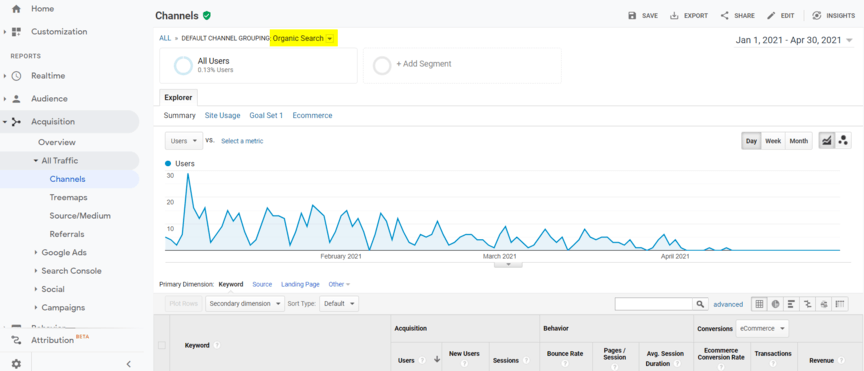
If you’re curious about which search engines drive traffic to your site, view “Source/Medium” from the “Acquisition” report. Use the search bar above the table to filter your results by organic search traffic — just enter “organic.” You’ll then see how much traffic you received from different search engines.

Keep in mind that a few factors will influence your organic search traffic numbers, like:
- What keywords you rank for, and how much monthly search volume they receive
- Whether the keywords you rank for experience seasonal shifts in search volume
- How long you’ve been optimizing your website for SEO
- Whether a Google algorithm update impacted your site
- And more
If you’ve only been investing in SEO for a few months, expect lower organic search traffic numbers. Typically, companies start to see noticeable results from SEO after three to six months of optimizing their website.
2. Bounce rate
Tools: Google Analytics
Bounce rate is another metric you can use to measure SEO performance. This metric, which you can view in Google Analytics, measures the percentage of single-page sessions or sessions where someone arrived at your site but didn’t visit any other pages on your site.
For example, say someone arrives at your blog post, “How to Bake a Pie.” While you feature links to related articles throughout this blog post, the person doesn’t click on those links. Instead, they visit your blog post, “How to Bake a Pie,” and then leave your site.
Companies can use bounce rate to:
- Find gaps in the user experience, like a slow page speed
- Evaluate how well a page delivers on user search intent
- Analyze page improvements, like a redesign, and their impact on the user experience
If you want to check out your bounce rate, log in to Google Analytics and follow these steps:
- Click “Acquisition”
- Select “Channels”
- Choose “Landing Pages” from the “Secondary dimension” dropdown menu
Open the advanced filter and use the following settings:
- Include > Default Channel Grouping > Containing > organic
You can then view page-specific bounce rates of organic search traffic.
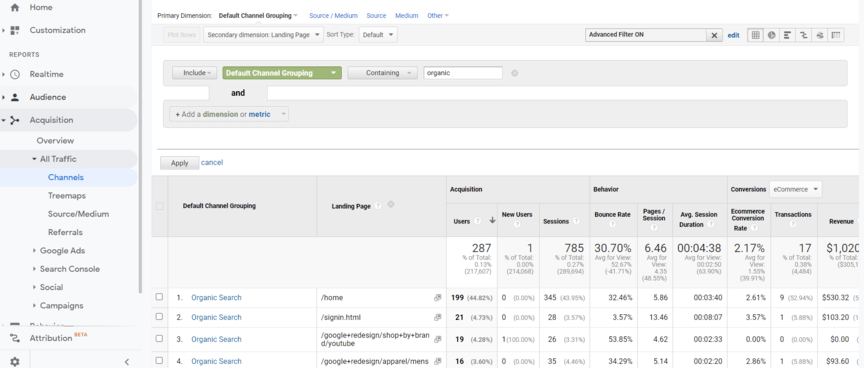
When using bounce rate to measure SEO, it’s important to mention that a high bounce rate isn’t always bad. A high bounce rate can signal you answered a user’s question and provided them with the information they needed to take the next step.
Someone looking to bake a pie, for instance, is likely focused on one of the following:
- Determining what ingredients they need
- Following the recipe and steps outlined
- Double-checking the instructions
So, it makes sense they visited your blog post and then bounced from your website. Based on that person’s experience with your site (and the tastiness of your recipe), they may return to your site later to find another recipe to try.
Remember this factor when using bounce rate to analyze your SEO performance.
3. Average session duration
Tools: Google Analytics
Average session duration is another metric you can use to evaluate your SEO.
Exclusive to Google Analytics, average session duration measures the average length of a session. A session is the period of time a user is active on your site — sessions will expire or end after 30 minutes of inactivity.
You can check out your average session duration by using the previous setup for viewing bounce rate.
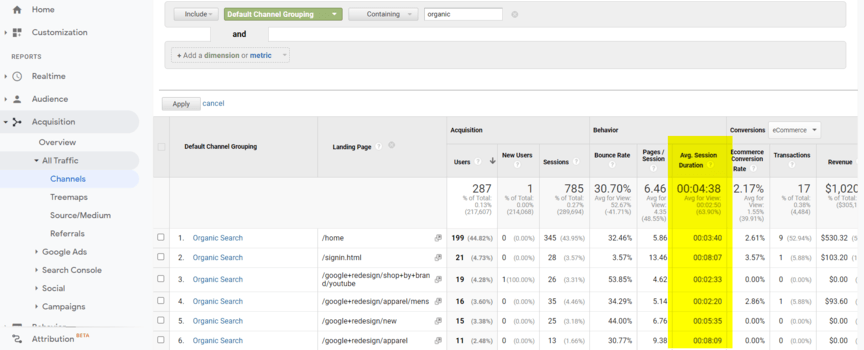
Instead of checking out the “Bounce Rate” column, though, you’ll look at the “Avg. Session Duration” column. Your average session duration will depend on multiple factors, like your internal linking, content length, website usability, and more.
If you notice certain landing pages have short average session durations, you’ll want to investigate.
A page that isn’t mobile-friendly, for example, could cause a high bounce rate and short average session duration. Since people can’t use the page on their smartphones, they leave, which hurts these Google Analytics metrics and your SEO rankings.
4. Keyword rankings
Tools: Google Search Console, Ahrefs, Semrush, or Google Search
Where you rank in search results directly impacts your SEO performance. If your site doesn’t rank well, you’ll see less organic search traffic, which influences your SEO results, like leads captured, sales earned, and revenue generated.
You can check out your keyword rankings with a few tools, including:
- Google Search Console
- Ahrefs
- Google Search
While Ahrefs is paid, Google Search Console is free.
In Google Search Console, you can view your keyword rankings by following these steps:
- Click “Search results” under “Performance”
- Select the checkbox for “Average position”
- Click the “Pages” tab
- Choose the URL you want to view keyword rankings for
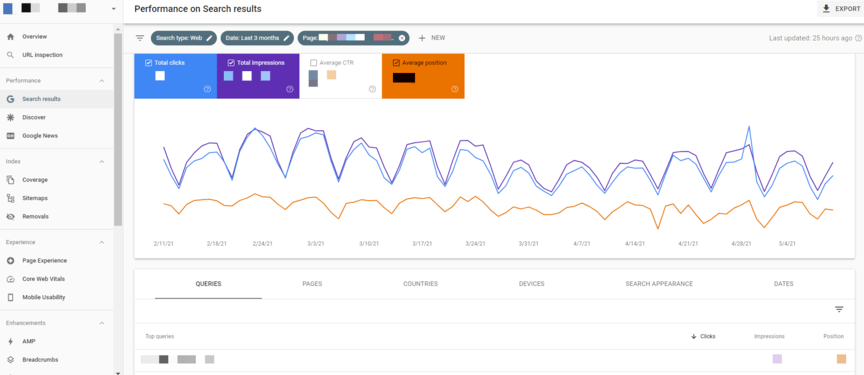
This process is manual and time-intensive. While you can import the data into Google Data Studio, which will make it easier to work with, you may find a paid tool like Ahrefs or Semrush faster and easier to use.
Based on your findings, you can evaluate your SEO performance.
For example, you can outline top-ranking pages for company decision-makers and share that page’s organic search traffic, bounce rate, and average session duration. You can also compile pages to re-optimize for SEO, which can help improve their rankings.
5. Backlinks
Tools: Google Search Console, Ahrefs, Moz, Semrush
Backlinks are one of the most critical off-page SEO factors. That’s because backlinks serve as an endorsement of your site, especially when they come from websites that search engines already see as trustworthy.
As part of your SEO strategy, you’ll likely focus on building or attracting backlinks to your site, like by:
- Conducting outreach
- Creating content
- Building tools
- Developing viral content, like infographics
- And more
When it comes time to evaluate your SEO performance, you want to check your backlink profile. Growing your backlink profile with authoritative links can demonstrate to company stakeholders that you’re improving your off-page SEO, which will influence your ranking ability, traffic, and more.
You can check your backlink profile with a few tools, including:
- Google Search Console
- Ahrefs
- Moz
- Semrush
In Google Search Console, for example, you can view the “Links” report to see:
- Which pages receive the most external links
- Which pages receive the most internal links
- Which sites link to your website the most
- Which anchor text gets used the most to link to your site
Again, you’ll likely find a paid tool offers more convenience and faster assessment of your SEO results.
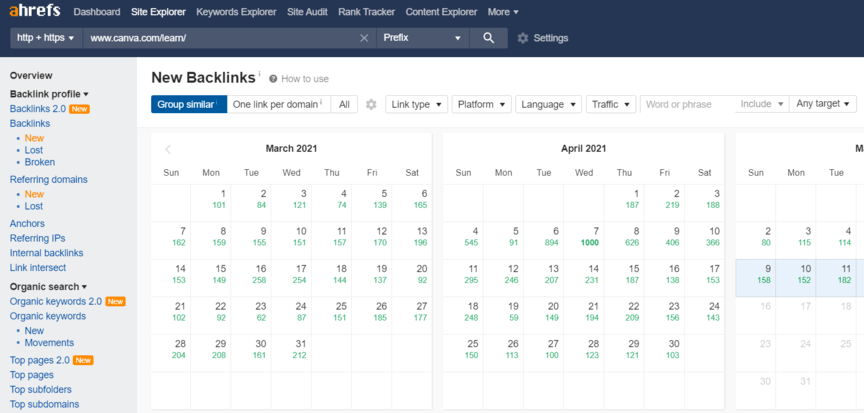
In Ahrefs, for instance, you can view the following reports to track your backlinks progress:
- Backlinks: New
- Backlinks: Lost
- Backlinks: Broken
- Referring domains: New
- Referring domains: Lost
No matter how you monitor your backlink profile, it’s critical to measure your off-page SEO performance. As your off-page SEO improves, like by building an authoritative backlink profile, your SEO rankings and SEO results will improve.
6. Conversion rates
Tools: Google Analytics, MarketingCloudFX
Conversions track valuable actions taken by users on your website — or other channels, like email and social media. When measuring SEO performance, though, you’ll likely focus on your site’s conversion rates through Google Analytics.
In Google Analytics, you’ll need to set up conversion tracking.
The way you set up conversion tracking depends on how you earn your revenue. A business with an ecommerce store, for example, will likely use ecommerce tracking in Google Analytics. In comparison, a service-based company will likely use event-based conversion tracking.
If you’re looking to learn how to set up conversion tracking, skip ahead.
Once you set up conversions for your website, you can measure your SEO results.
Just follow these steps in Google Analytics:
- Click “Conversions”
- Select “Ecommerce” or “Goals” based on your goal setup
If you’re an ecommerce business, the “Ecommerce” report will have several sections, which you can review from the perspective of organic search. That means you can see which products discovered through organic search sell best or how checkout rates for organic search compare to other sources.
If you’re a lead generation business, the “Goals” report will highlight goal completions by source, like organic search traffic. You can also view additional reports, like “Reverse Goal Path” or “Goal Flow,” to see how users went from arriving on your site to becoming a lead.
For a more in-depth look at your SEO results, you can invest in a paid platform, like MarketingCloudFX.
MarketingCloudFX will help your business measure and evaluate your SEO by revealing:
- How many phone calls organic search generated
- How many qualified leads organic search generated
- How many sales (and how much revenue) organic search generated
You can also use MarketingCloudFX to personalize website experiences, record user behavior, and more. Essentially, MarketingCloudFX is a marketing suite that allows you to upgrade all your marketing efforts — and measure your bottom-line results.
7. Return on investment (ROI)
Tools: Google Analytics
Discussions on how to measure SEO often focus on tracking your traffic, keyword rankings, and bounce rate. Those metrics are important and do provide insight into your SEO performance. More important than these metrics, though, is your return on investment from SEO.
Is your company making money from SEO? That’s the question you need to answer.
You can measure your return on investment from SEO through Google Analytics.
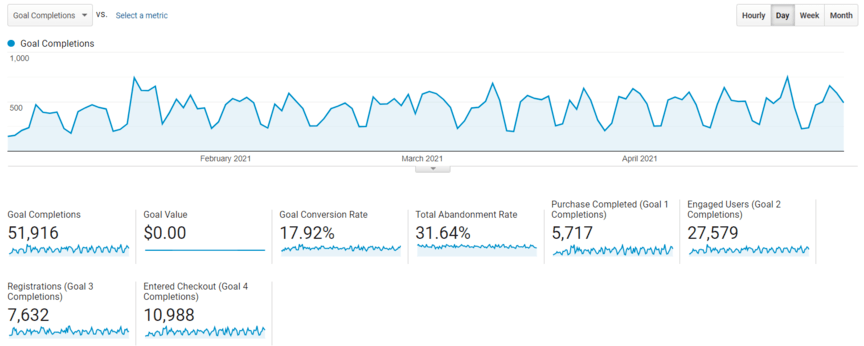
Just refer back to your “Goals” reports. If you use ecommerce tracking, you’ve already tracked the number (and amount) of sales generated through organic search. Custom goals, like a new lead, will also have a dollar value associated with them.
Besides these goals, you’ll also want to track your investments in SEO, like your:
- Software costs
- Hiring expenses
- Agency costs
Tally up your expenses against your gains, and you can calculate your SEO ROI. In most cases, you won’t see a return on investment from SEO in the first three to six months since the strategy takes some time to deliver. As your company’s marketing manager, you’ll want to manage expectations here.
Now, if you’re looking to learn more about how to measure SEO ROI, check out our breakdown below!
Don’t miss our Marketing Manager Insider emails!
Join 200,000 smart marketers and get the month’s hottest marketing news and insights delivered straight to your inbox!
Enter your email below:
Inline Subscription Form - CTA 72
"*" indicates required fields
(Don’t worry, we’ll never share your information!)

How to measure the ROI of SEO
So, how do you measure the ROI of your SEO efforts?
You’ll need to use the ROI formula:
- Set up conversion tracking
- Collect your SEO data
- Filter your conversions by channel
- Add up your SEO investments
- Calculate your SEO ROI
Let’s look at each of those steps in more detail.
1. Set up conversion tracking
Using Google Analytics, you can determine how much of your revenue came from organic search.
To get started, set up conversion tracking in Google Analytics. The way you go about this depends on how you earn your revenue.
For ecommerce websites
If you run an ecommerce site and make sales directly on your site, Google Analytics can pull revenue data from your transactions.
To start tracking data, enable ecommerce tracking. Then, to access your data, click on Conversions, then Ecommerce, and then Overview.
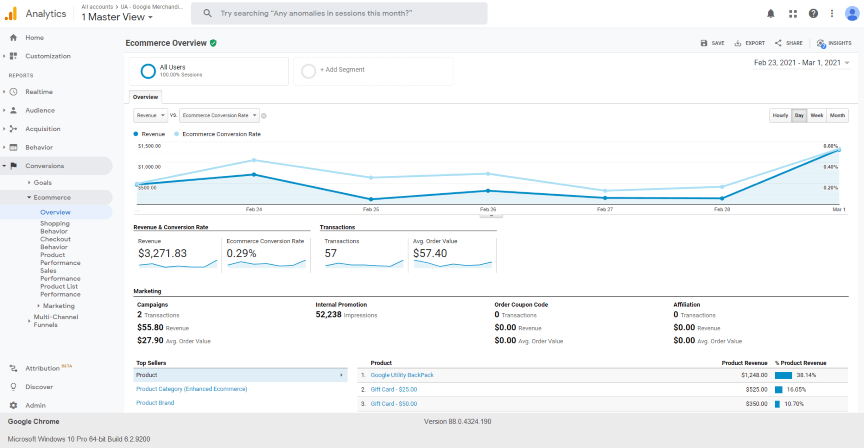
For lead generating websites
The process is a bit trickier if you don’t make sales directly on your website but instead generate leads from your site.
However, you can come up with a useful estimate by setting up goals in Google Analytics.
First, go to Admin and select Goals under View and set up goals representing your on-site conversions, such as form submissions or phone calls. Then, assign estimated values to those conversions based on past sales data.
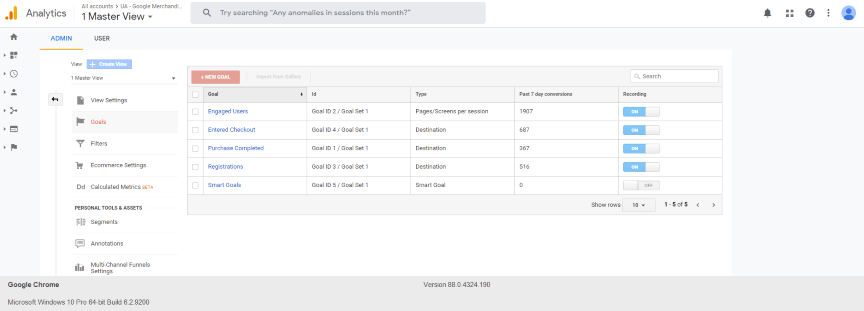
2. Collect your SEO data
Once you have tracking set up, Google Analytics will start collecting data about your SEO campaigns and website activity.
You’ll have to wait at least a month to gather enough data to get useful insights.
If you’re just getting started with SEO, you’ll likely have to wait three to six months to see an impact. SEO is a long-term strategy. It takes time to start seeing an ROI, but SEO delivers meaningful results over the long term.
You’ll want to track your SEO data continuously. Consider measuring it by month, quarter, and year.
3. Filter your conversions by channel
Next, you’ll need to filter your conversions by channel to see which ones came from SEO.
To do this, in Google Analytics, go to Conversions, then Multi-Channel Funnels, and then Assisted Conversions.
Leads and customers often have multiple interactions with your website before they convert. For this reason, it’s important to use the Assisted Conversions report. This report divides the value between the various touchpoints.
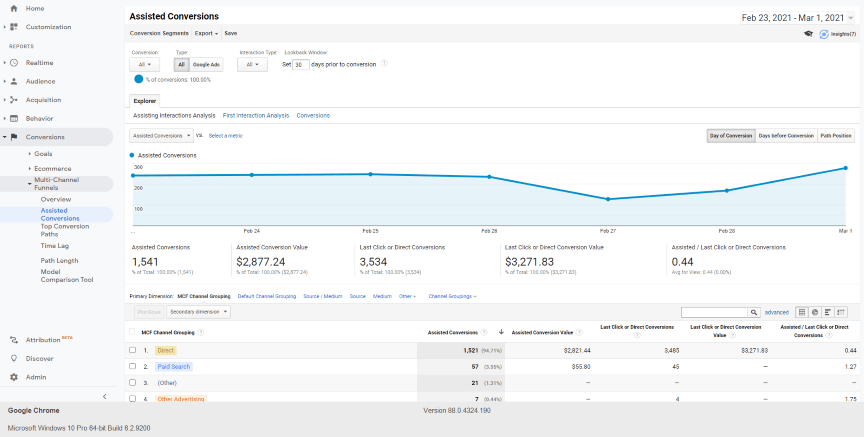
For example, if someone found your site via a search engine but then returned the next day via an ad and converted, the Assisted Conversions report would divide the value between these two channels.
At the top of the page in the Assisted Conversions report, choose Conversions at the top of the page.
The report will then show you your conversions sorted by the channel they came from. The conversions in the Organic Search channel came from search engines and can be attributed to your SEO efforts.
4. Add up your SEO investments
You’ll need to determine how much you’ve invested into your SEO to determine how much you gained from it. To get this number, add up your SEO investments.
If you work with an agency for all your SEO efforts, this number may simply be the cost of your SEO services. If you do some SEO in-house, you’ll need to determine how much time employees spend on SEO.
Don’t forget to include the costs of any tools you use as part of your SEO strategy.
5. Calculate your SEO ROI
Using the above methods, calculate your costs and revenue for a certain period, such as a month or quarter. Make sure you compare costs and returns for the same period.
Then, plug those numbers into the ROI formula:
(Gain from Investment – Cost of Investment) / Cost of Investment = ROI
Why track SEO results?
Tracking and measuring your results is crucial for marketing. SEO is no exception.
Why is it so important to evaluate SEO efforts and measure their results?
SEO requires maintenance
SEO offers the advantage of long-term value, but it’s not a set-it-and-forget-it strategy. To preserve your rankings and organic traffic, you need to perform regular SEO maintenance.
With SEO, you face constant competition, as other websites continually publish new content and update their existing content. To keep up, you have to do the same.
Google also regularly updates its algorithms to rank search results, so you need to adjust your strategies according to these updates.
When you measure your SEO, you can keep a better eye on what content you need to update and determine what changes you need to make.
Evaluating SEO helps you improve your tactics
Measuring your SEO also helps you improve your strategies and tactics in a more general sense.
You can see which methods are performing best and concentrate more of your efforts on those tactics. You can also determine what’s not working and what you need to change.
For example, you might find your website ranks particularly well for a certain set of keywords. This would give you insight into your audience’s interests and what Google believes your pages discuss.
You might also find that pages with videos perform well with organic visitors, leading you to create more videos for your pages.
Measuring SEO helps you demonstrate the value of SEO
To prove the value of your SEO efforts to company decision-makers, you need to track and measure your campaigns’ return on investment (ROI).
Gathering performance and ROI data enable you to demonstrate to company leaders the benefits SEO provides for your business. Convincingly showing your SEO work’s value can help you earn more funding for SEO and improve your results even further.
SEO affects your business’s bottom line
Having a strong presence in search is essential for today’s businesses. More than 90% of online experiences begin with search engines, and more than half of website traffic comes from organic search. What’s more, organic traffic captures more than 40% of revenue.
What all this means is that SEO is a strategy worth paying close attention to for your business.
Tools for measuring and evaluating SEO performance
The tools you choose will play an integral role in how effectively you measure and assess your SEO. You have numerous options when it comes to SEO tracking tools, but here are some of the top candidates.
Google Analytics
We’ve already discussed how you can use Google Analytics to evaluate your SEO, but this tool is so useful that it’s worth mentioning again.
As mentioned earlier, you can use Google Analytics to measure conversions resulting from your SEO efforts and determine your SEO ROI.
You can also explore numerous other metrics that affect your SEO, such as how people arrive on your site and how they interact with your site, including the pages they visit and how long they stay on each page.
And that’s just the beginning of this free tool’s capabilities.
Google Search Console
Another powerful, free tool for tracking SEO results is Google Search Console, a tool created by Google specifically for monitoring websites’ search engine performance.
In Google Search Console, you can check whether Google can crawl and index your pages, how your site is ranking, and how many other websites link to yours.
You can also determine which keywords your pages are ranking for and compare your search engine performance during different periods.
Google Data Studio
Google Data Studio is an excellent tool for analyzing and reporting on your SEO data.
You can pull information into Google Data Studio from tools like Google Analytics and Google Search Console and create in-depth reports to help you analyze and visualize your data.
The easy-to-read dashboards are perfect for reporting on your SEO work and demonstrating its value.
MarketingCloudFX
MarketingCloudFX is our proprietary digital marketing platform here at WebFX. It includes several powerful tools for tracking your SEO performance.
Powered by IBM Watson, MarketingCloudFX collects billions of data points to help you track campaign performance and make strategic decisions.
AnalyticsFX, one of the tools within MarketingCloudFX, tracks SEO metrics such as keyword rankings, changes in search visibility, and usage of search engine features.
It displays this information in easy-to-read reports and offers AI-powered recommendations for improving search engine performance.
MarketingCloudFX also includes detailed ROI dashboards that make it easy to track and evaluate your SEO ROI over time. These customizable dashboards track various ROI-related metrics and offer helpful visualizations and reports.
In addition to ROI, MarketingCloudFX helps you track your:
Ahrefs
Ahrefs is another useful tool for assessing your SEO. You can analyze your entire website’s search engine performance, sections of your website, and individual pages.
This tool provides you with lots of valuable SEO performance information, such as your keyword rankings, backlinks, and estimated traffic value.
You can also find data on keywords, such as how many searches they get per month and how difficult they are to rank for and examine the SEO performance of your competitors’ websites.
Our digital marketing campaigns impact the metrics that improve your bottom line.
See More Results
WebFX has driven the following results for clients:
$6 billion
In client revenue
24 million
Leads for our clients
7.14 million
Client phone calls
How WebFX can help you evaluate and improve your SEO
At WebFX, we understand the importance of evaluating your SEO and measuring your campaigns’ ROI.
That’s why our SEO packages come with advanced performance tracking tools and regular reporting.
When you work with us, you’ll get access to MarketingCloudFX and the powerful SEO tracking, analysis, and reporting capabilities it provides.
You’ll also receive regular reports from your account manager, updating you about your campaigns’ progress and results.
Plus, you’ll have a team of more than 500 digital marketing experts on your side that’s focused on driving positive ROI and meaningful results for your business. Over the past five years, we’ve driven more than $6 billion in results for our clients.
If you’d like to learn more about how we can help you track, analyze, and improve your SEO ROI, contact us online or call us today at 888-601-5359!

 Kevin Randolph
Kevin Randolph